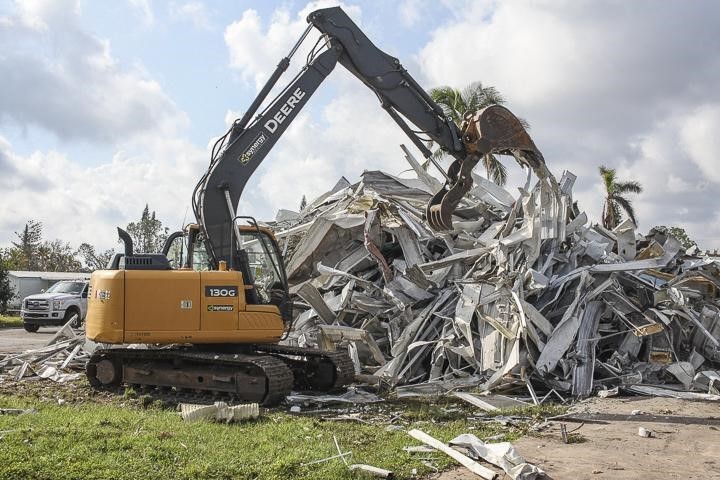The trail of destruction left by Hurricane Irma as it churned along the west coast of Florida in 2017 included a high-end resort hotel with an adjacent golf course, spa, entertainment center and numerous restaurants.
The sheer size of the property made for a complicated claim. An insurance program with separate policies for individual buildings, various sublimits and multiple deductibles set at 5% of the value of each structure at the time of loss added to the challenge.
Representatives for McLarens, JS Held, MDD Forensic Accountants, and the Zelle law firm held up the example of “Differing Policies in Paradise” during a webinar Thursday to expound on how claims professionals can get their arms around the broad spectrum of issues that arise in a complex catastrophe claim. The presentation was sponsored by the Property & Liability Resource Bureau as part of its Large Loss Webinar Series.
The claims adjuster, engineer, accountant and lawyer made three main points: Get to the site fast, communicate continuously with all involved and carefully document and allocate costs to the appropriate silos.
“What’s important initially is to listen,” said Jake Mello, senior vice president for the J.S. Held engineering firm. “I know that’s sometimes hard to do. When we get engaged in a project, the first thing we want is to do.”
The PLRB panelists did not identify the damaged resort, but the slides they displayed during the webinar showed that it was in Florida and within the path of Hurricane Irma.
Gerry Griffin, a senior executive adjuster for McLarens, said the resort complex included four separate buildings, each insured by a separate policy. The storm damaged those structures and also uprooted trees and inundated the golf course, forcing it to close for two months while contractors replaced the irrigation system, resodded greens and rebuilt sand traps. The resort’s beach had to be regraded and and a temporary spa had to be erected while the permanent building underwent repairs.
Griffin said there were multiple owners representatives who requested frequent updates about the adjuster’s review. There were also brokers involved and a broker’s accountant who wanted details about the dollar amount of the loss.
Mello, the JS Held engineer, said his company arrived on scene less than 24 hours after Irma cleared the area. He said by arriving early, he was able to get involved in the initial discussions as the owner and contractors developed a recovery plan. Mello said when claims professionals engage long after such talks are underway, they can be seen as a barrier to solving problems rather than part of the solution.
Mello said it is crucial to understand the dynamics of the team you are working with. He said sought out the contracted property manager for the resort and walked the property to understand what damaged systems were critical to reopening.
“Understand who the decision makers are,” he said. “Understand who the other interested parties are.”
Because each building and the grounds were covered by a separate insurance policy, it was essential to carefully allocate costs. Theodore Woodburn, a manager with MDD, said the resort’s claim produced 12,000 separate line items.
“That was a pretty big Excel sheet,” he said.
MDD arranged expenses in tables to ensure that costs were assigned to the correct insurance policy, Woodburn said.
“Make sure that the expenses were actually incurred,” he said. “Was there an invoice?”
Careful accounting can protect insurers, but in one instance it favored the policyholder. Woodburn said one invoice for carpeting had been assigned to hotel lobby but actually belonged to the ballroom. That increased the size of the owner’s payout because damage to the hotel was not costly enough to breach the policy deductible, but damages to the ballroom were above the deductible.
Nick Dolesji, a partner with the Zelle law firm, said detailed accounting was especially important because of the separate policies that covered the resort’s grounds. Damaged trees on the golf course were treated differently than trees not on the golf course because a $5 million sublimit applied to “tees, greens and fairways,” while the rest of the grounds were covered by a policy with a $2.5 million sublimit for land improvements, he said.
Woodburn said his spreadsheet listed every plant that was replaced, allocated to the correct policy.
“That was quite bit of paperwork,” Dolesji said.
The PLRB’s Large Loss Webinar series included a separate presentation Thursday on claims related to COVID-19. The series will continue on Feb. 11 with a webinar on “historic” New York City home water losses and on Feb. 25 on “red-tagged” earthquake-damaged apartment buildings.
About the photo: Clean up begins in Fort Myers, Florida following Hurricane Irma. Robert Kaufmann/FEMA</p>
Was this article valuable?
Here are more articles you may enjoy.


 OpenAI And Microsoft Sued Over Murder-Suicide Blamed on ChatGPT
OpenAI And Microsoft Sued Over Murder-Suicide Blamed on ChatGPT  Hermès Heir Sues Arnault and LVMH in $16 Billion Suit Over Lost Shares
Hermès Heir Sues Arnault and LVMH in $16 Billion Suit Over Lost Shares  Losses Top $20 Billion in Asia Floods as Climate Risks Grow
Losses Top $20 Billion in Asia Floods as Climate Risks Grow  Tricolor Trustee Plans to Sue Founder for Auto Dealer’s Collapse
Tricolor Trustee Plans to Sue Founder for Auto Dealer’s Collapse 